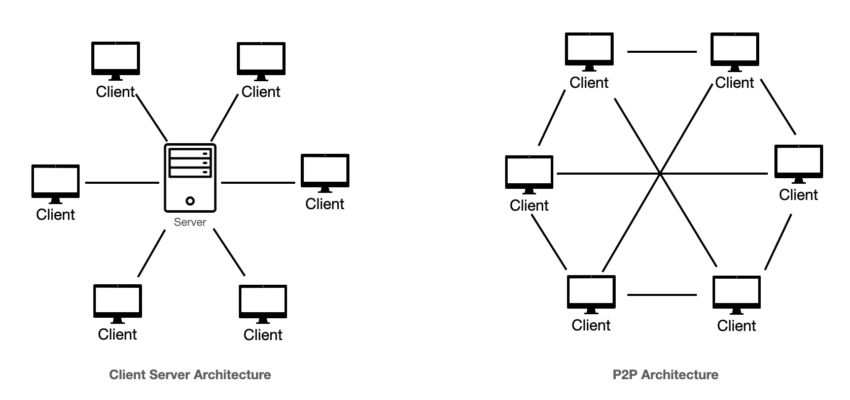One of the key elements of web3 is the use of the blockchain — a decentralized, public ledger that facilitates peer-to-transactions. One element of this technology is that users are required to contribute to the maintenance of the network. Much of this is done through running nodes. This guide will cover the importance and role of nodes in blockchain technology.
KEY TAKEAWAYS
► Nodes maintain the integrity and security of the blockchain network by validating transactions and relaying data between peers.
► There are different types of nodes, including full nodes, light nodes, and archival nodes, each serving unique roles based on their purpose.
► Running a node supports the blockchain ecosystem, strengthens security, and allows participants to take part in governance decisions.
► Setting up a node can require minimal hardware, making it accessible to individuals with basic technical knowledge or through node provider services.
What are nodes?

The term “node” originates from scientific, mathematical, and technological fields and applies to various contexts. At its core, they are a:
- A point of connection
- A redistribution or communication hub
- A device connected to a network
- A device that sends, receives, stores, and processes data
In blockchain technology, nodes are computers or other devices (like servers or mobile devices) that maintain a copy of the blockchain database, validate transactions and blocks, and update other devices on the blockchain’s state.
Nodes in blockchains are peer-to-peer, meaning they communicate directly with one another without relying on a central authority. They play an important role in validating transactions and blocks and relaying updates to other devices within the network.
A web-like structure best illustrates how devices interconnect, with each one linked to one or more nodes. This decentralized configuration ensures that even if one point fails, the overall network continues to function without interruption.

Why are nodes important?
Decentralization is one of the elements that has made crypto an alternative to the mainstream financial system. Bitcoin and most other networks are not controlled by one entity — instead, control belongs to the community members across a distributed network.
Their role is to ensure that the network is running smoothly. These validators confirm that nobody uses the network to break the protocol’s rules. It also helps confirm that transactions cannot be altered or double-spent.
Nodes contain a full copy of the entire blockchain, which functions as a universal ledger system. Any interested party can verify transaction information on the network from any point in its history, which means that the legitimacy of all transactions can be verified.
Information about transactions, blocks, and the state of the blockchain is communicated. Ultimately, nodes contribute to providing consensus among blockchain users. This is the consensus algorithm at work, which works as a rulebook for how devices agree on the state of the blockchain.
Using a consensus algorithm
Because there are no central authorities vetting transactions on the decentralized blockchain, this is done through the validators.
The consensus algorithm takes all the information provided by the nodes and ensures that they have reached a common “agreement.” This ensures the security and reliability of the network transactions. This agreement can be:
- The order in which transactions were submitted
- The head (most recent block) of the blockchain
- State of the accounts on the blockchain
Essentially, the nodes guarantee that the info captured in the block is the only truthful version of events. They hold the software for validating information and interacting with the blockchain.
Types of blockchain node
Now that we know how the computers or similar devices within a network receive and share information, this information is used to maintain the network’s integrity and security.
However, the nodes themselves can have different characteristics. These usually involve their purpose within the network and their capabilities. Don’t let the different types confuse you, though; on the most basic level, there are two main types: full and light. Let’s look break it down.
| Node | Purpose |
|---|---|
| Full | Maintains a full copy of the database, validates transactions, and enforces protocol rules |
| Light | Uses SPV to validate blockchain and only interacts with the blockchain to send/receive transactions |
| Pruned full | A full node with pruned blockchain history to save space |
| Archival | Maintains a full history of the blockchain that cannot be pruned |
| Mining | A full node within a PoW mechanism |
| Masternode | A full node within a PoW that must lock up cryptocurrency to validate transactions and mint coins |
| Authority | A centralized node within a proof of authority (PoA) mechanism |
Full nodes
The full nodes sit at the heart of the blockchain network. They are especially important for the fact that they offer governance rights and enforce protocol rules. It takes a majority of votes for a proposal to be accepted. Furthermore, this majority can lead to the establishment of a hard fork.
Unlike others on the list, full nodes record the entire blockchain, noting the details of every single transaction. Validation of the network and maintenance of the consensus are its primary uses. Some full nodes can add blocks to the networks, while others cannot.
Light nodes
Lightweight nodes are another name for light nodes. The light nodes save up on storage space by downloading only select information, like the head of the blockchain. They use simple payment verification (SPV) to ensure that they are interacting with the correct version of the chain. However, the light nodes are unusable without full nodes.
Pruned full nodes
The pruned full nodes also help maintain storage space. They “prune” older blocks in the network by deleting them. In the end, the pruned full nodes maintain only the most recent transactions based on the storage specifications determined by the owner.
Mining nodes
Mining nodes use proof of work (PoW) to update the blockchain. To achieve this, the mining nodes are full nodes or retrieve the information from a node. Unlike regular nodes, the miners also receive rewards for the additional benefits that they bring to the blockchain.
Authority nodes
Authority nodes are of use to centralized blockchains. The owners of these networks will decide upon the validators of transactions. For example, if a company operates a blockchain, it may not allow everyone to operate a node. However, in purely technical terms, authority nodes have the same features as full nodes.
Masternodes
Masternodes are similar to full nodes. They exist in PoW mechanisms and operate similarly to mining nodes, except that they must lock up a certain number of tokens to validate transactions and mint coins.
Archival nodes
Archival nodes store the entire history of the blockchain, including all transactions, blocks, and states since the network’s inception. They maintain a complete, unaltered record of every block, which allows them to respond to queries about any point in the blockchain’s history.
For context, full nodes verify transactions and blocks, but they can be pruned, meaning they discard older transaction data to save storage space.
Why should you consider running a node?

Running a node has a key role in maintaining the smooth functioning of a blockchain network. They can earn financial rewards for the operator. However, this does not mean that the action itself does not carry advantages for both the individual and the community.
Firstly, you will contribute to the security of the blockchain network. Cryptocurrencies like Bitcoin would simply not exist without people doing this work!
Not only that, but you will be able to take part in the governance process. This means that you have a real say regarding, for example, system updates. And, in the event of a fork, you can express support for which version of the blockchain you believe is canonical.
Finally, while you may need to improve your technical knowledge, you will be happy to know that running a node is quite affordable. There is no requirement for expensive supercomputers, unlike the task of being a crypto miner.
An affordable computer, a strong internet connection, and a willingness to learn some technical aspects are the only requirements. Remember, not all nodes are full nodes, so a light node is completely realistic on limited hardware.
Basics of setting up a node

Running your own node can be a rewarding experience. This not only allows you to take part in the construction of the crypto ecosystem itself but also helps you attain new technical expertise.
While, yes, there are a number of technical aspects that require a greater degree of scrutiny, there are a number of elements that you need to be mindful of.
First of all, there are several minimum requirements. As mentioned previously, however, there is, generally, nothing outlandish involving computation power. Here is what most typically require:
- You will need a computer that uses a recent version of Windows, Linux, or macOS.
- You will need at least 2 GB RAM and 200 GB of free disk space.
- Finally, you will need a stable internet connection
The Raspberry Pi is one of the most popular devices used for running light nodes. The Raspberry Pi is a small, affordable computer with enough storage and computation power for this particular task. From here, you will need to install the hardware, the operating system, and the software.
Blockchain node providers
The node providers are an alternative to individuals running their own. These providers offer APIs that help developers create automated workflows for managing your particular setup.
As we mentioned earlier, there are numerous issues that users may not want or be able to deal with when setting up a node. These nodes-as-a-service provide the infrastructure required and reduce the difficulty involved in the task. Cloud mining, for example, is possible through services such as this.
These companies can provide access to blockchain networks such as Bitcoin, Ethereum, Monero, and others based on the requirements of the client. They allow the clients to access the blockchain information at any time.
The expenses of such services are determined by factors related to costs of setting up the node (personnel, hardware, software, etc.), as well as operating costs. Still, there are a number of highly popular providers such as Infura, GetBlock, and Alchemy. These companies boast good reputation and a large number of users.
Nodes are key to blockchain
Blockchain technology has a tremendous amount of uses. One of its key tenets, however, is the importance of adhering to a decentralized system. In order for this to work, the network depends on the contribution of regular users. They contribute to the functioning of the system.
Nodes help this kind of public network operate. Individuals may have various motives for running their own. Some do this to earn a profit, while others might also be concerned with helping the network run smoothly. Regardless, nodes remain the nerve receptors of the blockchain network and will continue to be integral to decentralized ecosystems in the years to come.
Frequently asked questions
What are nodes in a blockchain?
How many blockchain nodes are there?
What is a node in Bitcoin?
Is a wallet a node?
Are crypto wallet nodes?
Disclaimer
In line with the Trust Project guidelines, the educational content on this website is offered in good faith and for general information purposes only. BeInCrypto prioritizes providing high-quality information, taking the time to research and create informative content for readers. While partners may reward the company with commissions for placements in articles, these commissions do not influence the unbiased, honest, and helpful content creation process. Any action taken by the reader based on this information is strictly at their own risk. Please note that our Terms and Conditions, Privacy Policy, and Disclaimers have been updated.




